Purple is the color of spiritualism, supernatural, and imagination
This article is about the symbolism and meaning of the color purple, which is part of the Color Meaning Series.
For more information about the other colors, take a look at our guide on the meaning of the colors.
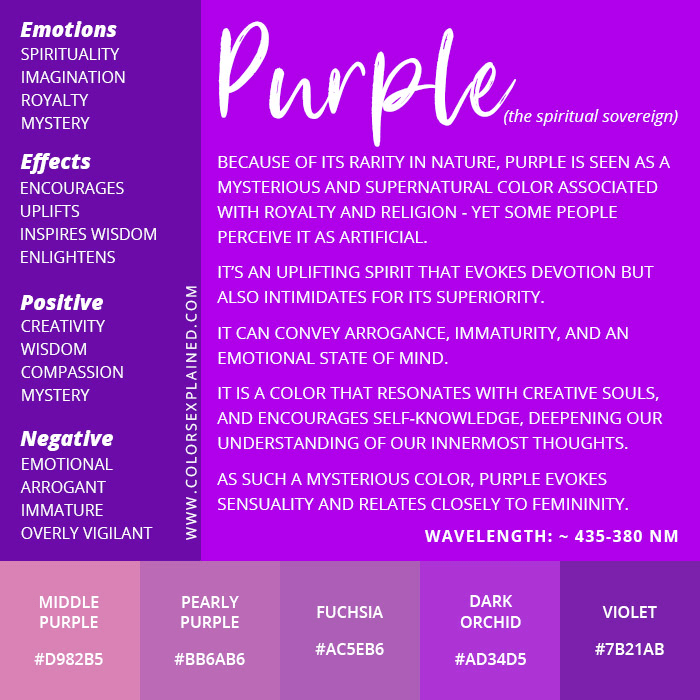
Where do we find the meaning of the color purple?
Is it in the starry, indigo galaxy? Or is it in the delicate flowers of a garden? Perhaps, we can find it underneath the earth in the mystical gemstones.
No matter where one shall look for the meaning of purple, this is a spiritual, feminine, and mysterious color, as we will talk about in detail below.
To give you a full picture of the symbolism and meanings of the color purple, we’ll also talk about its most common uses, company logos, chakra, gemstone, facts, quotes, and idioms.
Without delay, let’s dive into the color purple meaning, usability, and influence on us.
Purple Color Meanings in Different Cultures
In color psychology, each color has an undeniable influence on our behavior and impressions. It is a force we simply can’t avoid.
Yet, the way people perceive and interpret colors is also determined by their culture and traditions.
Colors have different meanings in different parts of the world – this concept is called color symbolism.
And like every color of the spectrum, purple also evokes cultural associations. Here’s how some societies interpret the color purple.
- In Hinduism, purple symbolizes peace and wisdom.
- In Catholicism, purple is closely associated with Advent and Lent.
- In Judaism, purple stands for redemption through God.
- In Egypt, purple symbolizes virtue and faith.
- In most African countries, it is a symbol of royalty and prosperity.
- In the United States, purple is the color of honor.
- In Brazil and Thailand, purple is a mourning color when worn together with black.
What Does the Color Purple Mean in the Bible?
The Bible uses colors to convey plenty of meanings. Purple is associated with royalty, authority, and the rich in the biblical color meanings.
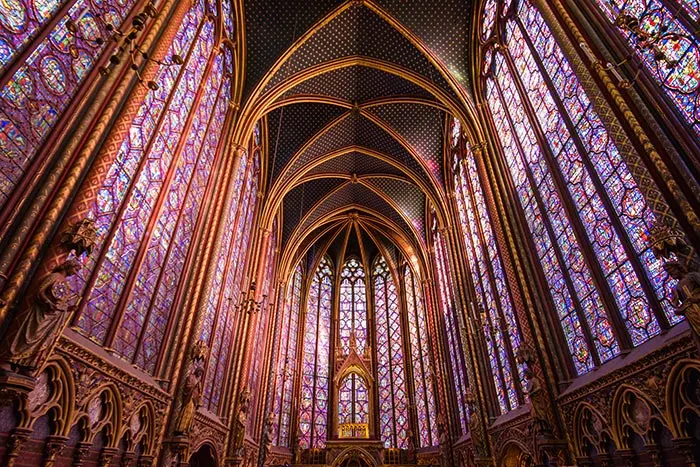
Psychological Meaning of Purple
The meaning of purple is fascinating.
Purple is a color associated with royalty, luxury, spirituality, and the supernatural.
These associations came from thousands of years ago when our world was just learning about the color purple.
In ancient times, producing dyes was a costly process that required a lot of effort. Still, some colors were especially expensive – or extremely expensive, as was purple.
The earliest purple dyes date back to 1900 BC, and it was remarkably rare to find any object or clothing in this color.[1]
According to the historian Beatrice Caseau, “10,000 shellfish would produce 1 gram of dyestuff, and that would only dye the hem of a garment in a deep color” (Bagnall, p. 5673).
These numbers are supported by the quantity of discarded shells, which, at the cities of Tyrian and Sidon, created 131-feet tall mountains.

Color Purple Meaning
Therefore explaining why the purple dye was worth more than its weight in gold, something that only the royal family could afford.
That’s the reason why clothing dyed using Tyrian purple was highly desirable and expensive.
- Purple was and still is relatively rare in nature.
- The dye’s production was difficult.
- And the color was resistant to fading.
As a result, Tyrian purple became a status symbol standing for wealth, power, and prestige.
Plenty of kings and emperors from Ancient Egypt and the Roman Empire, together with high-status men of the Catholic church, would wear purple garments and robes.
For instance, Queen Elizabeth II wore a purple robe at her coronation at Buckingham Palace.
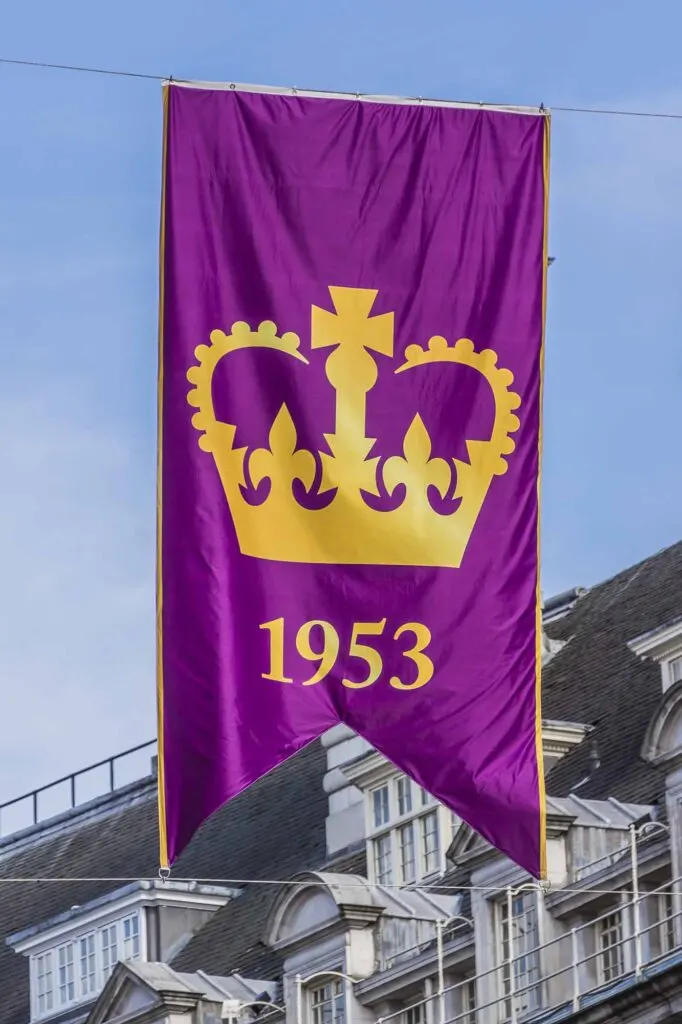
In the meaning of the colors, purple evokes power, mystery, extravaganza, and wisdom.
As expected, the negative meanings of purple are self-importance, conceit, and corruption.
Still, purple is also a combination of red and blue.
With red’s energy and blue’s calm, purple is a color that inspires reflection and self-awareness.
It balances the energy, power, and intensity of red and the relaxation, stability, and authority of blue, creating the perfect monarch.
For those reasons, purple has always had a powerful and supernatural aura, which is why it often appears in religious constructions or celebrations, such as during Lent.[2]
It is an excellent color for meditation, too.
The color purple encourages self-knowledge, deepening our understanding of our innermost thoughts. It calls for spiritual growth and offers guidance in our personal pursuits, keeping the mind, body, and soul in harmony.
Purple, the seventh color of the rainbow, is the compassionate, intuitive soul, the introvert. As a unique and independent spirit, purple is insightful, uplifting, and undeniably beautiful, enticing with ease.
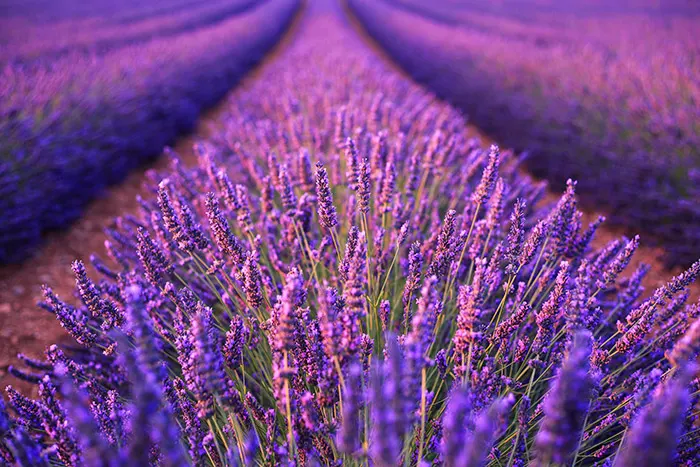
It assists in spiritual fulfillment and transformation of the soul. And although the color purple enhances our spiritual enlightenment and relates to daydreaming and escaping from reality, it also keeps us grounded.
It’s a color of unconditional self-love, compassion, and sensitivity.
Unsurprisingly, purple is often used in humanitarian, psychic, feminine, and religious industries.
Because purple is so rare in nature, a large number of people consider it an artificial color. In contrast, others find it sacred, intriguing, and superior.
Purple relates to the deep, distant places in outer space, evoking mystery. It is a color that is connected to the unknown, soothing, and conveying wisdom.
And because it can be a somewhat intimidating and mysterious color, purple embodies sensuality. It evokes femininity, especially in its paler and lighter tints.
Lavender, for example, is the “grown-up” pink. It represents the graceful woman and is associated with beauty and femininity.
It is a compassionate color that advocates for peace. Still, it can be hypersensitive, especially when chaos is around, leaving one in an emotional state.

For those reasons, purple is one of the most polarizing colors of the spectrum. People either love it or hate it. That’s mostly influenced by age and gender.
Among women, it’s the second favorite color, only after blue, according to research led by Joe Hallock. Women and adults between 25-69 years old have a higher preference for purple than men and youth.[3]
As expected, Hallock says not many men like purple, despite the fact they associate the color with courage and bravery. Purple comes in third place as the least-liked color for men.
All things considered, purple calms the mind and nerves, uplifts spirits, enhances the sacred, and creates feelings of spirituality. If you’re feeling stressed out, having purple flowers around might soothe your mood.
It is a color that removes perceived spiritual obstacles, encourages imagination, and increases sensitivity.
However, overuse of purple can invoke irritability, impatience, arrogance, and even aggravate depression.
It is an intense and ambitious color that entices a sense of magic and devotion in our souls.
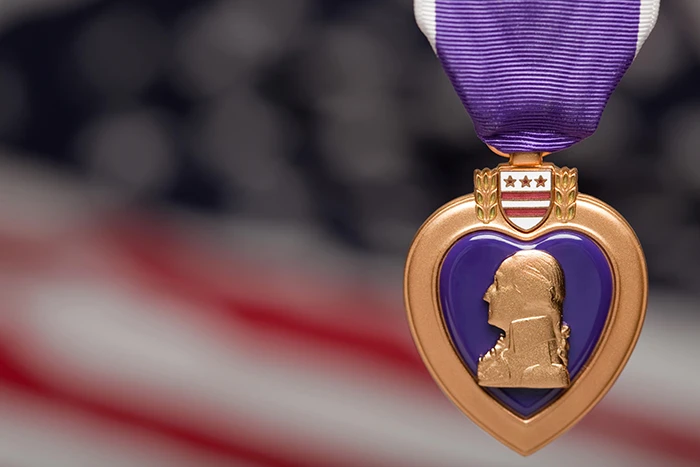
Purple acknowledges there is an immense unknown to be discovered, leaving room for imagination and unbiased thoughts.
After all, violet is located at the far end of the visible spectrum, lying at the edge of the imagination as well.
Because purple evokes so much creativity and imagination, it’s no wonder this color resonates with artists of all kinds, from passionate writers to thoughtful painters.
Purple is an intense color, but it is also the most powerful visible wavelength of electromagnetic energy.
Its waves are the shortest of all colors, and therefore, the strongest.
The smaller the wavelength, the smaller the structures with which they interact, and the more powerful the energy. Therefore, violet at 400 nm~ is more powerful and stronger than red at 700 nm~. (nm=nanometer)
Of all colors of the spectrum, purple is the closest to x-rays and gamma rays, which are harmful.
Because of its shorter wavelengths, violet is the hardest color to distinguish. Eg., ultraviolet is not visible to the eye.
Physical Effects of Purple
As we touched on earlier, every color has physical effects on us, including the color purple. Purple can:
- Calm – Purple has calming effects on the mind and nerves. Light tints of purple are considered relaxing colors.
- Enlighten – Its sense of spirituality puts us in the right place for introspection and self-discovery.
- Encourage imagination – It fosters creativity by awakening our senses.
Personality Color Purple
If purple is your favorite color, or you have many purple things in your home, it will reflect on your personality and how you interact with others. It has a direct impact on who you are too.
Curious now? Then, you might want to read about the personality color purple.
Meanings of Purple Shades
Lavender: It’s a color that lends softness and yet creates a sense of respect. It is mostly considered feminine in western cultures.
- Lavender hex code: #A689E1
Lilac: It’s a pale, soft shade of purple connected to romance and affection. Its association with flowers conjures innocence, nostalgia, and youth.
- Lilac hex code: #C8A2C8
Violet: Standing at the end of the visible light spectrum, violet evokes royalty, creativity, confidence, and individuality.
- Violet hex code: #8F00FF
Indigo: As a natural pigment that comes from plants, indigo is considered one of the seven major spectral colors. It symbolizes wisdom, higher knowledge, devotion, frustration, and sad feelings.
- Indigo hex code: #4B0082
More Shades of Purple
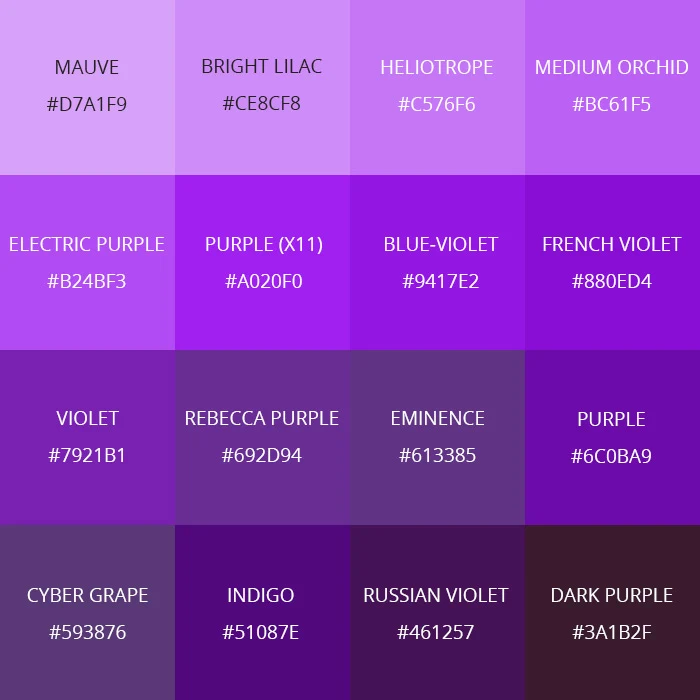
Here are some more shades of purple: lavender, orchid, lilac, violet, Russian, Fuschia, plum, puce, thistle, mauve, magenta, royal, mulberry, pomegranate, eggplant, wine, amethyst.
Most Common Uses of Purple
Purple is commonly used to promote feminine products, toys, and spiritual and technology services.
Companies and Brands That Use Purple in Their Logo
In business, purple is commonly used to promote feminine and technology items as well as brands that want to promote themselves as superior and wise.

Purple Chakra
Each chakra color has its meaning rooted in the meaning of those colors.
The crown chakra, Sahasrara, also known as purple chakra, is located at the top of the head, and it controls the spiritual connection and self-knowledge.
It stimulates people to express themselves the way they feel and to connect with the higher power.
Purple Gemstone
Purple gemstones are believed to enhance creativity, intuition, imagination, and to offer protection, cleansing, and wisdom to discern the best use of one’s energy.
Facts About Purple
- Purple is a secondary color that is complementary to yellow, according to the CMYK color model. On the other hand, it is complementary to green according to the RGB color model.
- Purple is the meeting point between warm red and cool blue and consists of many shades in between. Because of this, purple retains both warm and cool properties. On the one hand, it is considered warm at the magenta and maroon end and cool at the violet end.
- The United States Military awards purple hearts to soldiers wounded in battle.
- Only two national flags have purple in them – Dominica and Nicaragua.
- Purple is simply a mix of blue and red, whereas violet is visible in the light spectrum.
Quotes About Purple
Here are some lovely quotes about purple.
I think it pisses God off if you walk by the color purple in a field somewhere and don’t notice it.
Alice Walker
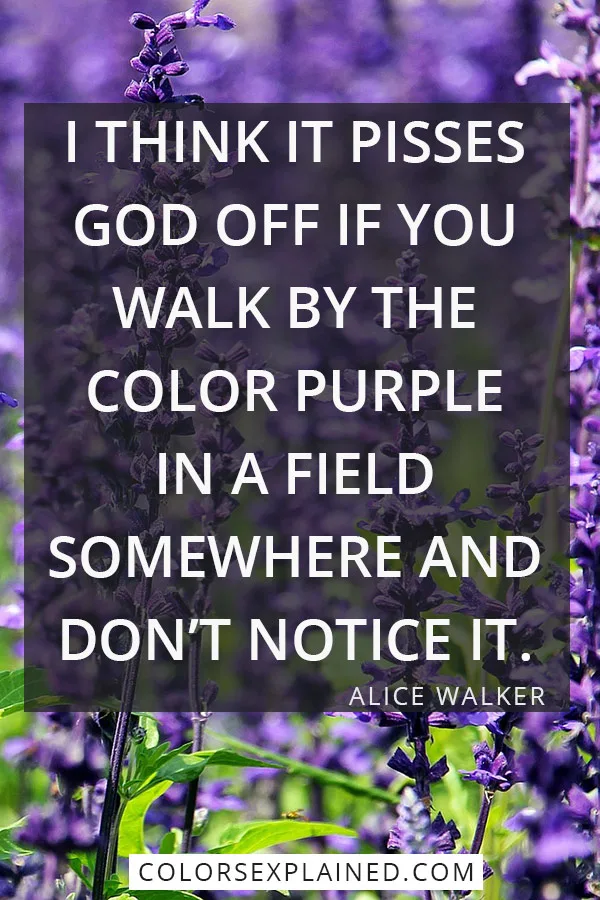
Be eccentric now. Don’t wait for old age to wear purple.
Regina Brett
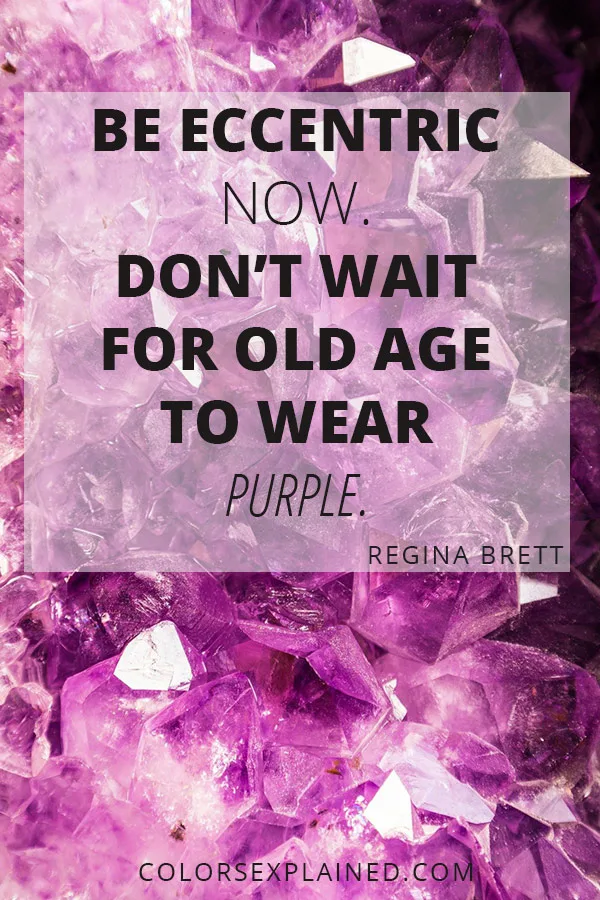
Violet has the shortest wavelength of the spectrum. Behind it, the invisible ultraviolet. Roses are Red, Violets are Blue. Poor violet violated for a rhyme.
Derek Jarmen
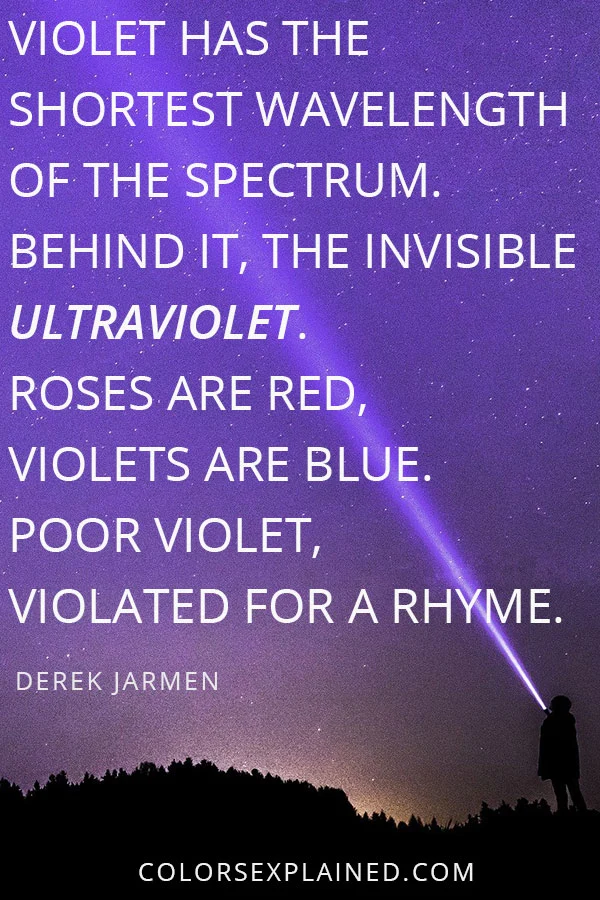
Purple puts us in touch with the part of ourselves that is regal. Purple is the queen in all women; it helps us keep our backs straight and heads held high.
Byllye Avery
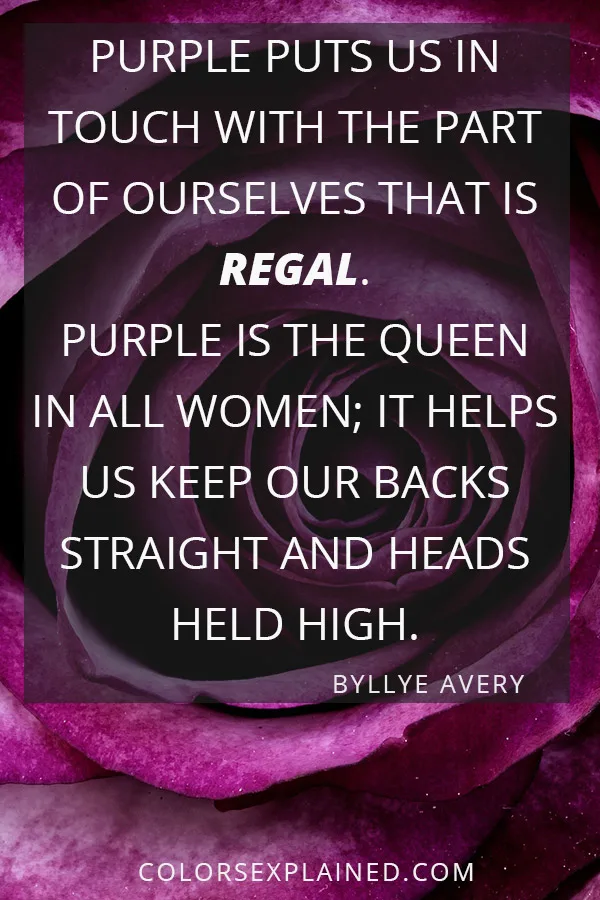
Womanist is to feminist as purple is to lavender.
Alice Walker
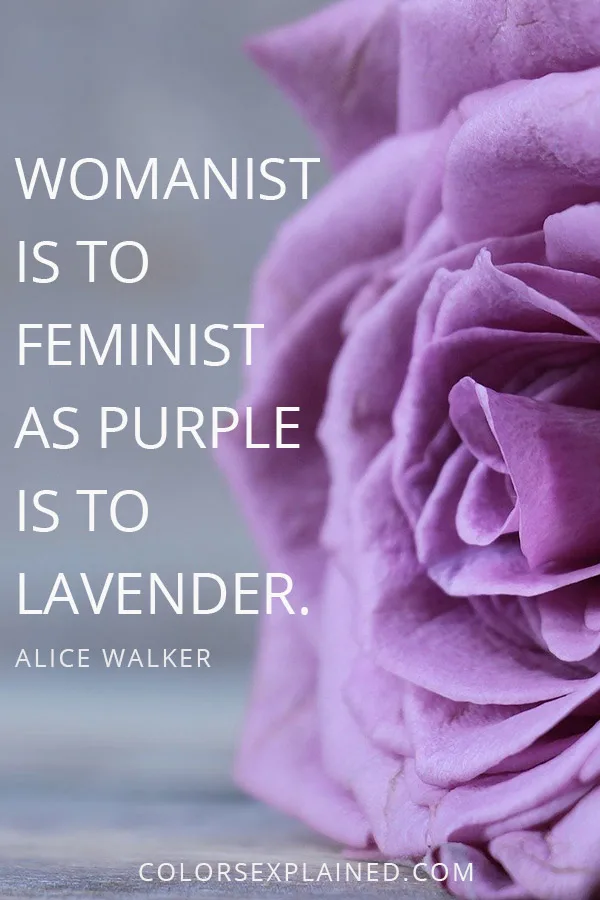
Popular Idioms With the Word Purple
- Purple cow: The purple cow theory argues that being innovative, unique, and remarkable – like a purple cow – is the only way to come through the highly competitive market of the modern era.
- Born in the purple: It refers to members of royal families born during the reign of their parents.
- Purple prose: A prose that is too elaborate, exaggerated, or ornate.
- Lay it out in lavender: To lay someone out in lavender means to scold someone severely.
- Purple speech: It is used to describe profanity and bad language.
- Shrinking violet: An exaggeratedly shy person.
Summary Color Purple Meaning
Because of its rarity in nature, purple is seen as a mysterious and supernatural color associated with royalty and religion – yet some people perceive it as artificial.
It’s an uplifting spirit that evokes devotion but also intimidates for its superiority.
It can convey arrogance, immaturity, and an emotional state of mind.
It is a color that resonates with creative souls, and encourages self-knowledge, deepening our understanding of our innermost thoughts.
As such a mysterious color, purple evokes sensuality and relates closely to femininity.
Purple means: spirituality, imagination, royalty, mystery
Effects of purple: encourages, uplifts, inspires wisdom, enlightens
Positive traits: creativity, wisdom, compassion, mystery
Negative traits: emotional, arrogant, immature, overly vigilant
Bibliography
Bagnall, R. et al. The Encyclopedia of Ancient History. Wiley-Blackwell, 2012

Yange Silas
Monday 14th of November 2022
What is the full mean of purple color